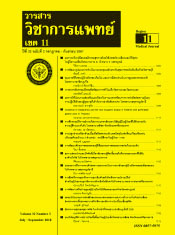Effects of The Self-Efficacy Enhancement Program on Registered Nurses’ Competencies in Blood Culture Techniques and Reducing Blood Culture Contaminate Rates
Keywords:
the self-efficacy enhancement program, registered nurses’ competencies in blood culture techniques, reducing blood culture contaminate ratesAbstract
The purpose of this quasi-experimental research, one group pretest - posttest design was to investigate the effects of the
self-efficacy enhancement program on registered nurses’ competencies in blood culture techniques and reducing blood culture contaminate rates. The samples were 48 registered nurses who work in medical wards in MaharajNakhonsithammarat Hospital and Blood culture specimens collected by subjects were 192 specimens. The subjects
received the self-efficacy enhancement program based on Bandura’s social learning theory for 8 weeks. Data were collected by a blood culture recording form and the registerednurses’ competencies in blood culture techniques questionnaire. The results of the content validity index was .95. Data were analyzed using percentage, mean, standard deviation, chi-square and paired sample t-test.
The results of study
1. Registered nurses’ competencies in blood culture techniques after receiving the self-efficacy enhancement program were significantly higher than before the intervention (p<.05).
2. Blood culture contaminate rates after receiving the self-efficacy enhancement program were significantly higher than before the intervention (p<.05)
References
Rep; 2016; 5 (1): u206760.w2754.
2. Bates DW, Goldman L., Lee TH. Contaminate blood culture and resource utilization: The true consequences of false-positive results. Journal of the American Medical
Association; 1991; 265 (3): 365-369.
3. Thwaites GE, Edgeworth JD, Gkrania- Klotsas E. Clinical management of Staphylococcus aureusbacteraemia. Lancet Infect Dis; 2011; 11: 208-22.
4. จุติรัตน์ มากมิ่งจวน, สินาฏ คุณอารี, วัชรีย์ แสงมณี. การพัฒนาการเจาะเลือดส่งตรวจเพาะเชื้อ หอผู้ป่วยเด็ก 1 โรงพยาบาลสงขลานครินทร์. Princess of Naradhiwas University
Journal; 2553; 2 (1): 106-120.
5. Shahangian S, Snyder SR. Laboratory medicine quality indicators: A review of the literature. American Journal of Clinical Pathology; 2009; 131(3): 418–431.
6. GarcíaAlM, Carnero SA, Romero GA, Aguilera GA. Hemocultivo. Importancia en el mediohospitalario. ROL de Enfer- mería; 2011;1 73: 27-30.
7. Sanchez BR, Rincon FB, Cortes FC, Fernandez CE, Pena Cueva S, de lasHeras Castro EM. Hemocultivos, Quetehan- contado y quehaces. Enferm Glob;
2012; 11 (26): 146-63.
8. Tarrand JJ, LaSala PR, Han X-Y, Rolston KV, Kontoyiannis DP. Dimethyl sulfoxide enhances effectiveness of skin antiseptics and reduces contamination rates of
blood cultures. Journal of Clinical Micro- biology; 2012; 50(5): 1552–1557.
9. Hall KK, Lyman J.A. Updated review of blood culture contamination. Clinical Microbiology Reviews; 2006; 19(4): 788–802.
10. Mark E.R, R Jennifer C, Cole Mel, Lyden. Reduction in blood culture contamination through use of initial specimen diversion device. Clinical Infectious Diseases;
2017; 65 (2) 201–205.
11. Hsues PR, Teng LJ, Pan HL, Ho SW, Luh KT. Nosocomial pseudoepidemic caused by Bacillus cerustraced to contaminate ethyl alcohol from a liquor factory.
Journal of Clinical Microbiology; 1999; 37 (7): 2280-2284
12. NoskinGa, Suriano T, Collins S, Sesler S, Peterson LR. Paenibacilliusmacerans care unit. American Journal of Infection Control; 2001; 29 (2): 126-129.
13. Chih-Jan C, Chi-Jung W, Hsiang-Chin H, Chiu-Hui W, Fang-Ying S, Shou-Wen W, et al. Factors associated with blood culture contamination in the emergency
department: critical illness, end-stage renal disease, and Old Age. PLoS ONE; 2015; 10 (10): e0137653.
14. Bandura A. Self-efficacy: The Exercise of Control. New York: W.H. Freeman and Company; 1997.
15. นภสร ดวงสมสา วิลาวัณย์ พิเชียรเสถียร , พิกุล บุญช่วง. ผลของการพัฒนาคุณภาพโดยทีมพยาบาลต่ออัตราการปนเปื้อนเชื้อจุลชีพในเลือดที่ส่งตรวจเพาะเชื้อ. พยาบาลสาร; 2556; 40 (4): 12-20.
16. Arif A-H, Maha A-I, Eman Al, Waseelah A-AJ, Jaffar A, Hassan A. Nurses’ competency in drawing bloodcultures and educational intervention toreduce the contamination rate. Journal of Infection and Public Health; 2016; 9: 66-74.
17. Andrew D Harding, Susan B. Reducing blood culture contamination rates in the emergency department. Journal of emergency nursing; 2013; 9 (1): e1-e6.
18. Akpaka P, Christian N, Bodonaik N, Smikle M. Epidemilogy of coagulase- negative staphylococci isolate from clinical blood specimen at the university hospital
of the west indies. West Indian Medical Journal; 2006; 55 (3): 170-173.
19. นริศรา ธรรมทัช, วิลาวัณย์ พิเชียรเสถียร, พิมพาภรณ์ กลั่นกลิ่น. อัตราการปนเปื้อนเชื้อจุลชีพในเลือดส่งตรวจเพาะเชื้อที่เก็บโดยถุงมือปราศจากเชื้อกับถุงมือสะอาด.พยาบาลสาร, 2559: 43 (4): 55-66.






